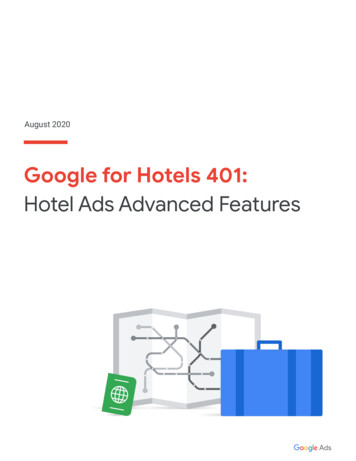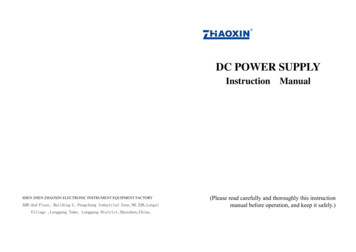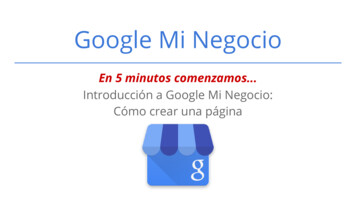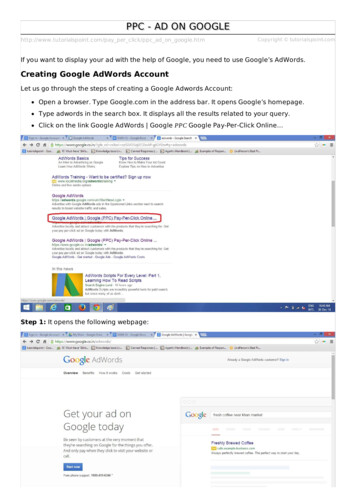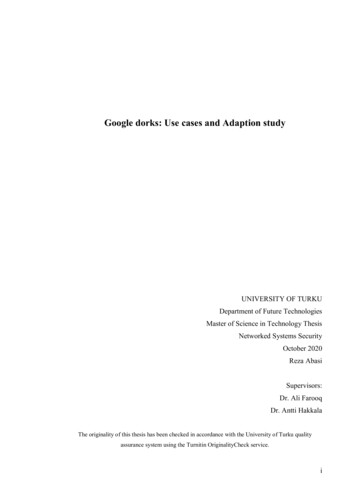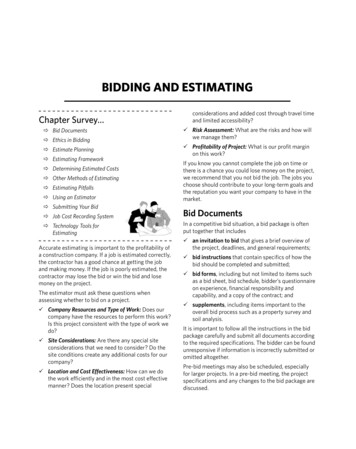
Transcription
Display SmartBidding Guide
Table of ContentsOVERVIEW AND HOW IT WORKS3SETTING UP SMART BIDDING5MANAGING SMART BIDDING8ASSESSING RESULTS9SEASONALITY AND PROMOTIONS11CREATIVE BEST PRACTICES WITH SMART BIDDING11SUMMARY OF KEY CONCEPTS12FAQS13NEXT STEPS142Display Smart Bidding Guide Table of Contents
Overview and How It WorksSmart Bidding is Google’s set of free programmatic bidding tools which manage your bids across all devices to drivemore conversions and increase your advertising efficiency. Smart Bidding helps deliver the best possible performanceagainst your goals with the greatest possible efficiency. This guide is for advanced users who want a detailed overview ofDisplay Smart Bidding and how to implement it in the most optimal manner. It contains best practices for setup,campaign management, and reporting in addition to transparency into how our algorithm works. For a more basicdescription of Smart Bidding, please see the Google Ads Help Center.Today we offer four main Smart Bidding strategies based off of conversion or conversion-value goals. These are:Maximize Conversions, Target Cost-Per-Action (Target CPA), Maximize Conversion Value (closed beta)*, and TargetReturn on Ad Spend (Target ROAS). All of these strategies can be used from day one of starting your campaign, and werecommend this as a best practice. The only exception is Target Return on Ad Spend, which requires a minimum of 15conversions within a 30-day window.Conversion Based StrategiesValue Based StrategiesMaximize ConversionsMaximize Conversion Value (closed beta)The algorithm tries to drive as much conversionThe algorithm automatically sets bids at auction timevolume as possible given your budget; you do notto get you as much conversion value as possibleprovide a specific CPC, CPA or ROAS target. Canwithin your campaign’s budget. This strategy helps youeven be used without conversion tracking,spend your budget as efficiently as possible withoutalthough we recommend conversion data for bestrequiring a lot of work to set it up. There are also zeroperformance.eligibility requirements, similar to other maximizestrategies.Target CPAThe algorithm predicts the conversion probabilityTarget Return on Ad Spendof each impression to achieve the maximumThe algorithm predicts both conversionnumber of conversions within your target CPA.probability and expected conversion value to tryto drive the maximum total value from all of yourYou can also choose one of three payment modes:Pay forconversions within your target ROAS.DescriptionClicksPay the cost for every user who clicks on your ad.Maximize Conversions,Target CPA, Maximize ConversionValue and Target ROASConversionsPay the cost for every user who converts on your ad.Eligible advertisers using Target CPA(reports with Last Click Attribution)* Reach out to your sales team to indicate interest and discuss next steps.3Available forDisplay Smart Bidding Guide Overview and How It Works
Signals UsedOur programmatic bidding algorithm analyzes key attributes about each auction and determines conversionlikelihood. When used properly, the algorithm often delivers better performance than manual optimization whilesaving a significant amount of time.The algorithm considers a myriad of signals about each auction and over 70 million permutations of those signalswhen calculating a bid. The signals considered include:User behaviorContext of current web page and session Recency from leaving your site Content of website viewed How many pages a user viewed on your site Structure of website viewed Value of products viewed Keywords present on website viewed Time of day and day of week Conversion funnel progress Previous sites visited Cross-device behavior and conversions Remarketing list membership Conversion delayAd characteristics Format of advertisement Relative creative performanceUser characteristics Location Device InterestsHow Does the Algorithm Work?All smart bidding strategies use the same underlying Google Ads “programmatic bidding” algorithm. We model the entiremarket of auctions that the advertiser could participate in with different bids. The algorithm then determines the bestbidding rule to maximize volume and obtain the desired target or goal you set (i.e. Conversions or Conversion Value)STEP 1Advertiser defines the target in terms of conversions or conversion value and the algorithm models a conversionrate. For Maximize strategies, we look at your traffic and infer your CPA or ROAS goal.STEP 2The algorithm uses your business goal, predicted conversion rate, predicted conversion value, budget, and itsunderstanding of the entire market of auctions to determine the right CPC for each auction.STEP 3The CPC bid is converted to a CPM bid and compared with all other advertisers’ bids (both Google Ads andDSPs buying on AdX or other exchanges). Typically the advertiser with the highest CPM bid wins the auction;quality metrics such as click through rate are also considered.ONGOINGThe algorithm regularly evaluates predicted vs. actual conversion rates and predicted vs.actual CPA or ROAS todrive accuracy over time. When there is the potential for extreme under performance, our system will spend lessto help alleviate this volatility. We may spend less because the algorithm is unlikely to achieve conversions atyour target or we have not seen conversions come in as predicted. For Maximize strategies we will continue toevaluate your traffic and update your CPA or ROAS goal to achieve the best performance.4Display Smart Bidding Guide Overview and How It Works
Setting Up Smart Bidding1Choose the Right Smart Bidding StrategyUse the flowchart below to help you determine the Smart Bidding strategy that is the best fit for your business:PerformanceGoalConversion ValueConversionsCPA in mindconversion tracking requiredTarget CPA 20% more conversions*If eligible, use Pay ForConversions(billing change)conversion value tracking requiredPrioritize VolumeNo conversion tracking requiredMaximizeConversions 55% conversion uplift*Great for Budget ConstrainedClientsBest for new to displayadvertisersROAS in mindtROAS 30% more conversion value*Prioritize ValueMaximizeConversion Value(closed beta)Needs some historicalconversion data, at least 15conversions within 30 days* vs. manual bidding2Setting Smart Bidding Up for SuccessNow that you’ve chosen the right Smart Bidding strategy, ensure you are setting Smart Bidding up for success.Ensure conversion tracking is set up for best results.Smart Bidding relies on accurate conversion data for the algorithm as it learns and optimizes off this data. Ifthere is an issue with the Conversion Tracking, Smart Bidding will adjust and react to this inaccurateconversion data which can cause volume, CPA or ROAS fluctuations. We also recommend using Data-DrivenAttribution (pg. 9), if eligible, for the best reporting and optimization of your Google Display campaigns.Smart Bidding bids towards conversions from Conversion tracking, Google Analytics conversion tracking ifimported to Google Ads, as well as conversions imported to Google Ads via Offline Conversion Tracking.Check conversion volume in Google Ads and compare it to Google Analytics or the 3rd party conversiontracking tools you might use. If you notice a discrepancy between the two values, make sure to account forthat when calculating Target CPA/ROAS. Read more about setting up conversion tracking in our Help Center.!5Maximize Conversions without conversion tracking - You can use Maximize Conversionswith no conversion tracking, but having conversion tracking set up will typically generatethe best performance for all Smart Bidding strategies.Display Smart Bidding Guide Setting Up Smart Bidding
Set your targets:If you’re focused on conversions, start with Maximize Conversions or Target CPA immediately so the algorithm canbid based on conversion likelihood from the start. Target CPA doesn’t require conversion volume, but it does requireconversion tracking to be set up in your account. When creating a Target CPA campaign, our systems will provideinitial target and bid recommendations customized to your conversion history. For those with little or no conversionhistory, suggestions are network-based suggestions.If you’re focused on conversion value, and you’ve been running Max Conversions or Target CPA. Once you have aminimum of at least 15 conversions in a 30 day period, you can switch over to Target Return on Ad Spend. If you’resensitive to consistently hitting your target over a 30 day period, we recommend driving at least 30 conversions permonth, per ad group before switching. Some advertisers with relevant historical data may be eligible sooner becausethe programmatic bidding algorithm is able to evaluate historical performance at the advertiser domain level whichallows us to begin bidding effectively on a new campaign.Campaign and Ad Group Structure:Only segment ad groups when necessarySmart Bidding performs best when allowed to evaluate performance and optimize bids across as much traffic aspossible. Over-segmenting campaigns into many ad groups is discouraged unless there is a compelling businessreason. Smart Bidding focuses on conversion data at the ad group-level. If you need to segment, here are thescenarios under which you would want to segment your campaign:Segment if assigning different conversion values to user attributesIf you report conversion values and use target ROAS, Smart Bidding optimizes to deliver higher valueconversions in line with your ROAS goal. If you don't report conversion values but you know someconversions are more valuable than others, then you should use Target CPA and segment.Segment ad groups to show different creativeFor instance, show a brand focused creative to an upper-funnel user and a direct response creativeto a lower funnel user.Segment if you have specific insights the algorithm won’t knowFor instance, if you know time-to-departure is an important statistic use this metric to segment adgroups. Create one ad group targeting only users whose departures are imminent and another for userswith trips farther in the future and tailor creative messaging accordingly. Another common use case issegmenting for offline metrics or customer lifetime value.Segment to provide additional insight or reportingAnother time to create a new ad group is when you want to completely split out reporting betweentargeting or creative groupings. When you have two separate ad groups, you’ll receive statistics for eachad group on a separate line item in the Ad Groups report.Segment if you value new users vs. existing users differentlyMany advertisers set a higher CPA/lower ROAS target for new users.Segment if you see attribution discrepancies for different segments based on 3rd party reportingFor instance, if Google Ads reports 50% more conversions than a 3rd party reporting tool for yourkeyword targeted campaign, but only 20% more for in-market segments, you should segment to accountfor that.6Display Smart Bidding Guide Setting Up Smart Bidding
Campaign settings:BudgetFrequency CapsSmart Bidding performs best with an uncappedRemove any frequency caps as this can hinderbudget, so uncap the budget wheneverperformance by preventing us from appearing inpossible; budget constraints can hinderauctions with a high likelihood of converting.performance as the campaign is not able toSmart Bidding determines for each auction whatparticipate in auctions that may be highly likelythe likelihood of conversion is, thereby making itto drive a conversion. If you want to spend yourunnecessary to set a frequency cap.budget in full, use one of our “Maximize”Strategies.Ad RotationPayment ModeDepending on the Bid Strategy you will havethree options: pay for clicks, pay for conversionsRotation is set to “Optimize” when using Smartand pay for viewable impressions. WheneverBidding to ensure the system chooses a creativeusing Target CPA and eligible, choose pay formost likely to convert.conversions to remove fluctuations in TargetCPA achievement.?How does smart bidding work even if my campaign doesn't have any conversion history?The programmatic bidding algorithm is able to learn from how well publishers, keywords, andtargeting performs from aggregate conversion data, as well as evaluate historical performance atthe advertiser domain level. As a result of using this pre-existing learning, Smart Bidding performsbest by opting in new campaigns to Maximize Conversions or Target CPA from Day 1. Thesecampaigns typically outperform Manual CPC bidding even during the 2-4 week learning period.During the learning period, the bidding algorithm learns even more about what works for the specificadvertiser and campaign to further improve performance.?Are Enhanced CPC and Maximize Clicks bidding strategies still available?ECPC and Maximize Clicks are still available if your goal is driving clicks. For ECPC, the algorithm usesyour CPC bid and makes bid adjustments up or down to -100% based on conversion likelihood. MaximizeClicks automatically adjusts your keyword maximum cost-per-click (CPC) bids on your behalf.ImportantAlways start with targets that align with your Display historical CPA or ROAS when accounting for conversion lag (timebetween click and conversion). To get the historical CPA or ROAS, view the most recent 30 day timeline (adjust forconversion delay) and look at the average CPA or ROAS across Display campaigns. If current performance differssignificantly from your target, the algorithm may lower bids and your total volume may decrease. To regain volume,increase your CPA, lower your ROAS goal or expand targeting. If efficiency is more important, you can continue using yourcurrent target but remember to assess volume using the conversion volume chart on page 10.If enabling Target CPA in a campaign with no conversion history, use your CPA from other Display campaigns and/or yourbusiness goals to inform the ideal CPA. You can explore the CPA and volume trade off by raising/lowering your CPAtarget. Once the campaign gains enough data, you can use our bid simulator to further explore. Invest at least 2 weekswithout changes for the initial learning period - performance may be more volatile during this time as the algorithm makesoptimization decisions. You can see if a campaign is in learning mode by looking in the campaign status column.7Display Smart Bidding Guide Setting Up Smart Bidding
Managing Smart BiddingOnce you’ve turned on Smart Bidding and confirmed progress towards your goals after the initial 2 week ramp upperiod, very little manual campaign management is needed.Significant campaign changes will disrupt performance because the algorithm will need to learn and adjust to thenew settings. These changes include, but aren’t limited to, bid increases, adding new creatives, targeting and audiencelist adjustments. For example, if you just opted in to automatic targeting and became eligible for a significant numberof new impressions on which Smart Bidding doesn’t have historical data, you may see a short term performancedisruption. If you must significantly change a campaign currently running with Smart Bidding, make all the changes atonce to reduce learning time. You can check the status column to see if the algorithm is still learning your settings.!Seasonal & Promotional periods - As long as conversion rates aren’t changing drastically on a daily basis, TargetCPA/ROAS is the optimal way to achieve your CPA and ROI goals during short promotional or seasonal periodsIf you need to make optimizations to the campaign, limit bid changes to only /- 20% and wait a week betweenchanges. Small, infrequent target CPA/ROAS bid changes aren’t likely to cause a noticeable problem. If you have veryhigh conversion volume in an ad group (100 conversions per day) you can make more frequent changes.If you see a temporary performance decline, don’t panic! The algorithm learns over time and adjusts bids tocompensate for poor performance. Lowering the Target CPA or increasing the Target ROAS can significantly hurtvolume and performance — see chart below:Conversion delay is the cause of many perceived performance declines. It can take up to several weeks for someusers to see an ad and then convert. Advertisers pay the CPC cost almost immediately but the conversions for thoseclicks come in over time based on the set conversion window. As a result, very recent performance may look poor butgets better over time as more users convert and those conversions are attributed back to the day the click took place.Check your web analytics data to determine your average conversion delay. You can learn more about conversiondelay here and view your conversion delay in the Google Ads interface.8Display Smart Bidding Guide Managing Smart Bidding
Consider conversion delay when setting your conversion window to make sure you are capturing all conversions. Ifyou set a shorter conversion window it can help to see results more quickly and speed up Smart Bidding learning, butyou will not see the full impact of your advertising.If you have a conversion delay of longer than 7 days, it is more difficult to predict a conversion rate which will impactour ability to accurately hit your CPA or ROAS target. We wait until we have the majority of conversions recordedbefore determining if our predictions were accurate; so you may see volatility while we wait for sufficient data.If you are limited by budget, and performance is worse than your target CPA/ROAS, opt into Maximize Conversions orraise the budget until you are no longer budget constrained. Budget constraints can hinder performance as thecampaign is not able to participate in auctions that may be highly likely to drive a conversion.Assessing ResultsEvaluate overall performance to minimize statistical noise. Don’t focus too narrowly on individual ad groups or shorttime periods (such as performance on a specific day as short spikes can occur), especially if you set a target at thecampaign level. Make sure that the target CPA or ROAS is realistic based on historical average.In this chart, Ad Group C is performing above the goal CPAwhereas Ad Groups A and B are hitting the goal. Since thecampaign is hitting the goal, don’t pause Ad Group C or overallCPA for Campaign 1volume will suffer. The programmatic bidding algorithm willlearn attributes about Ad Group C which lead to CPA abovegoal and compensate with lower bids.TargetBest PracticesCombine Ad Groups C and B/A to maximize shared learningand allow Smart Bidding to optimize across your traffic —unless segmenting for one of the reasons in section.Use Pay for Conversions whenever available and eligible.Pay for Conversions means you will never pay more thanyou set as your Target CPA.Ad Group Ad Group Ad GroupABCExpand the date range considered to include multiple weeks -- last 30 days is a common lookback window.When evaluating performance, set a date range that accounts for delayed conversions. For instance, if youhave a 24 hour average conversion delay, don’t include yesterday in performance statistics.Data-Driven Attribution (DDA) for Smart bidding on YouTube & DisplayUntil now, Google’s non-last click attribution models have only been compatible with Search (incl. Shopping campaigns) forsmart bidding. Now, we’re expanding compatibility to cover YouTube and Display network traffic and events. Soon, theseattribution models will be available to all customers via Conversion Settings. If eligible, Data-Driven Attribution is the bestattribution model for reporting Display’s impact and smart bidding optimization for your campaigns. Upon switchingattribution models, you may possibly see conversion volume shift amongst campaigns.9Display Smart Bidding Guide Assessing Results
Smart Bidding Accuracy and Conversion VolumeSmart Bidding is more likely to perform at your target CPA or ROAS if you evaluate a time period with moreconversion volume. The chart below shows expected accuracy given the conversion volume in a time period orcampaign hierarchy evaluated. This chart applies to any reasonable account structure or time period analyzed.If one ad group out of a large campaign only has 15 conversions during a time period analyzed, we’d expect dailyCPA volatility in that ad group. The overall campaign might be consistently hitting the CPA over multiple daysthough. This chart does not apply for longer time periods (like all time or multiple months).Impact of Conversion VolumeNumber of Conversionsin Ad Group/Time PeriodCPA or ROASPerformance FluctuationReaction Timeto ChangesInitial LearningPeriodFewer than 30Medium to High (up to 100%)Slow (up to 2 weeks)Up to 4 weeks50Medium (up to 50%)MediumUp to 3 weeks100Low (up to 20%)FastUp to 2 weeks500Very Low (less than 20%)Very Fast (as few as 6 hrs)Up to 2 weeksConversion Volume and Lead GenerationFor lead gen advertisers, closed leads can often occur after a long process or with limited volume. Oursmart bidding systems work best with greater volume and the least conversion lag possible. For the bestresults, we recommend selecting a conversion action that balances proximity of a revenue-generatingevent to volume.Smart Bidding and Campaign ScaleOur programmatic bidding algorithm is designed to provide your campaigns with the most conversion volume atthe chosen performance goal. As the market shifts (e.g. inventory, conversion rate, seasonality, user behavior, etc),conversion volume and spend may fluctuate in order for our programmatic bidding algorithm to continue to meetyour performance goal. There are a few steps you can take to scale your campaigns:Increasing your CPA goal or decreasing your ROAS goalEach of these will allow our algorithm to bid higher in each auction resultingin a higher chance of winning impressions that result in conversions.Expanding your targeting with Optimized TargetingWe now offer an automated way of expanding your existing audience targeting with optimized targeting.We recommended enabling this setting to generate more impressions to bid on, so our algorithm isable to find more conversions.?How Does a Change in Conversion Rate or Bid Impact Scale?There is strong correlation between bid and scale, and conversion rate and scale. A bid or conversionrate increase results in more scale, whereas a bid or conversion rate decrease in less scale.10Display Smart Bidding Guide Assessing Results
Seasonality & PromotionsMore seasonal volume only improves Smart Bidding. As long as your conversion rate isn’t changing drasticallyon a daily basis due to short-term sales or other factors, Target CPA/ROAS is the optimal way to achieve yourCPA and ROI goals. If you’re running a flighted campaign for a quick promotion period, the minimum amount oftime where we recommend a smart bidding strategy is 7 days. We recommend Maximize conversions for such ashort window. Anything shorter than 7 days, we recommend Max CPC.If your conversion rate is changing drastically due to a short-term sale or seasonal event or holiday (1-7 days inlength), we have the ability to inform the algorithm of the expected spike. Reach out to your sales team todiscuss next steps.Creative Best Practices with Smart BiddingEnsure your creatives are well tailored to your audience. Try to avoid full creative swaps where you change all adcreatives in an ad group. If you need to do a full creative swap, expect a temporary performance shift while yournew ads gather performance history; scale will only return to previous levels if the ads perform similarly in termsof click through rate and conversion rate. New ads may have different performance vs. the current ads which canimpact the scale achieved.?Why Does Adding New Ads Impact Performance? Ad rotation settings affect which creatives enter the auction New ads don’t have performance history to understand their expected clickthrough andconversion rates — therefore Google automated bidding has less data to make a bidding decision When determining how much to bid for a particular creative, we evaluate factors such ashistorical CTR, CVR, device, publisher, ad size to set the bidMinimizing volatility when refreshing creative on Google Display Ads If using asset-based creative,s graduallyrotate in new assets and do not pause down Do follow all GDA creative best practices. Do use Maximize Conversions rather than Targetall existing assets at one time; performanceCPA or Target ROAS if you are changing allhistory for asset-based creatives iscreatives out weekly in an ad group.associated with both the individual assets aswell as the ad unit itself. So removing all ofthe assets can cause significant history loss. If using static uploaded creative, swap outone ad (per ad size) at a time and pause downthe lowest performer in the ad group - pausedon’t delete ads if you plan to relaunch. Do relaunch paused creative rather thanuploading the same creative again — we can Do not pause all creative assets in an ad group atone time - this results in performance volatility. Ifyou must swap out all, raise bids 20%. Do not drop bids at the same time you add newcreative assets to an ad group — Remember thatperformance of your creative impacts your scale if you add new ads or assets that drive lowerclick through rates or conversion rates, you maysee a drop in traffic and conversions as a result.use the old history to ramp up. If you’re using third party serving then youlimit the data google can optimize toward.11Display Smart Bidding Guide Seasonality & Promotions Summary of Key Concepts
Summary of Key ConceptsProvide More Conversion Data for Best Programmatic Bidding Performance Campaigns with significant conversion volume have more consistent data pointsfor the algorithm to learn from, and have fewer performance fluctuations over time If you’re looking at a date range for a campaign or set of ad groups with under 100conversions, expect more performance fluctuations Assess performance at the campaign level to evaluate resultsAlgorithm Can Adjust Quicker to Shorter Conversion Delays If you have a conversion delay of longer than 7 days, it is more difficult to predict a conversionrate which will impact our ability to accurately hit your CPA or ROAS target. Consider setting a shorter conversion window if feasible for your business model. This canhelp speed up Smart Bidding learning. Secondary option is to consider bidding towards a micro-conversion as these often have lessthan a 7 day conversion window (ie. email sign-up).Only Segment When Necessary If a campaign is segmented into many ad groups, individual ad groups may experienceperformance fluctuations due to low conversion volume. Remove unnecessary segmentation to ensure easy performance tracking.Do Not Manually Optimize — Smart Bidding optimizes for you, using the power of automation Can greatly improve ROI or increase volume (though not overnight) Doesn’t overreact to short term changes Only acts on statistically significant data If performance is not hitting the goal, the algorithm will adjust bids Uses Optimize for Conversions as the ad rotation setting to maximize performanceSet Campaign Settings According to Smart Bidding Best Practices Smart Bidding takes creative performance history into account but doesn’t decide whichcreative to show; Optimize for Conversions is the ad rotation setting anytime you are usingSmart Bidding. Smart Bidding doesn’t consider budget constraints. If you’re limited by budget and SmartBidding is having a difficult time reaching your goal, you can switch to a lower CPA or higherROAS to more effectively utilize budget.Evaluate Performance Using CPA and ROAS The algorithm goal is to achieve the maximum number of conversions within your target CPAor target ROAS. Thus, focus on CPA and ROAS metrics to determine performance. It isnatural for impression and click volume to fluctuate. As long as the campaign is achievingCPA or ROAS, volume fluctuation is normal due to auction dynamics.12Display Smart Bidding Guide Summary of Key Concepts
FAQsHow can I restart Smart Bidding? I don’t like the data it has already collected. Smart Bidding cannot be restarted but is always learning and reacting to changing auction environments, sorestarting is unnecessary.How can I let the algorithm know I expect an upcoming increase in conversion rate due to a sale or seasonal date? We are typically able to inform the algorithm of upcoming conversion rate changes due to a sale or seasonalevent. We recommend discussing this topic with your sales team.What devices or inventory types does Smart Bidding work for on display? Smart Bidding works across all devices and inventory types including Desktop, Tablet, GDA In-App Inventoryand Mobile.What do you recommend if I have low conversion volume? Consider bidding towards a micro-conversion that shows intent or likelihood to leave to a sale. This may besomething such as an time on site, pages visited or an email capture.Does it matter if the Target CPA or ROAS is set at the campaign or ad group level? No, Smart Bidding will work the same way regardless of where the target is set. However, ad group targetsoverride the campaign level target. Using Portfolio Bid strategies does not change how Smart Biddingoptimizes or the data uses.If I add multiple remarketing lists to one ad group will Smart Bidding bid differently for each? Yes, we will learn against and bid differently for each individual list ID.What is the best course of action if there is a site or pixel issue that affects data for Smart Bidding? We are able to blackout data in certain circumstances such as a site or pixel issue. We recommend discussingthe issue with your sales team to see if your situation warrants a blackout of data.How can I switch on Smart Bidding as quickly as possible? For Maximize Conversions and Target CPA, you can activate immediately. For Target ROAS, using MaximizeConversions or CPA allows the system to collect data most quickly. Do not use CPM bidding. Sometimes you’ll
Display Smart Bidding and how to implement it in the most optimal manner. It contains best practices for setup, campaign management, and reporting in addition to transparency into how our algorithm works. For a more basic description of Smart Bidding, please see the Google Ads Help Center.
